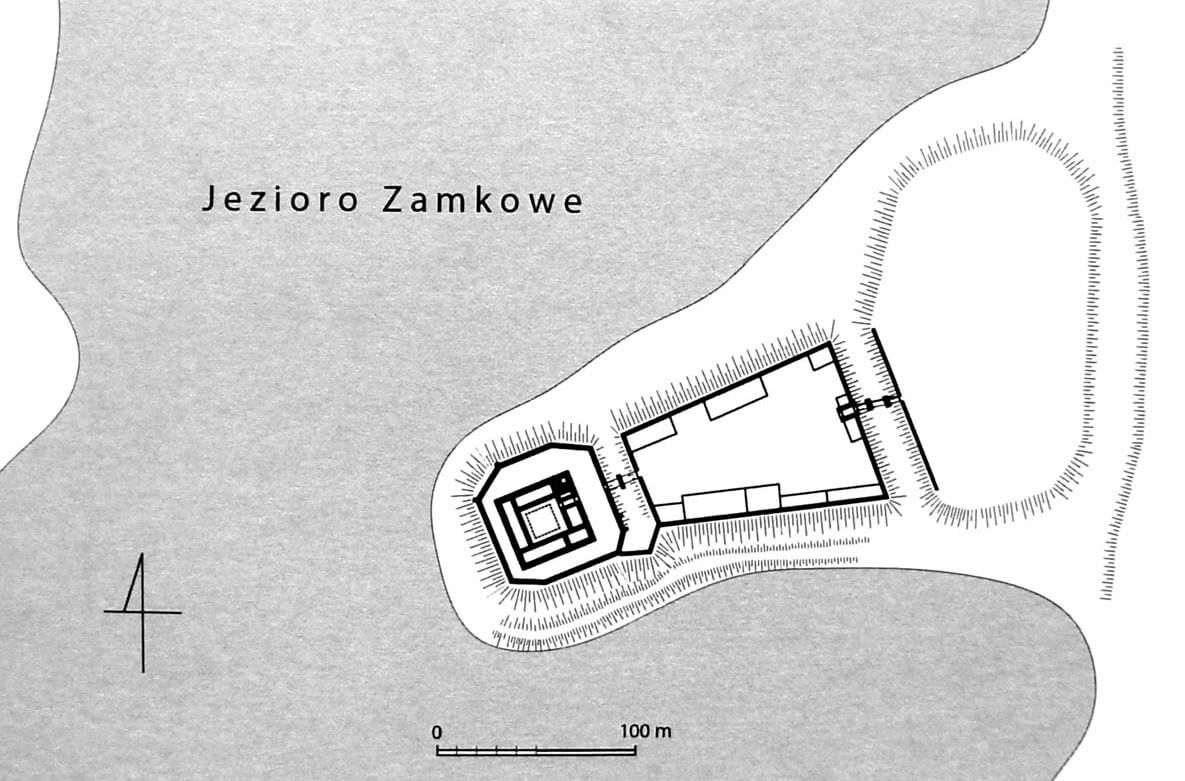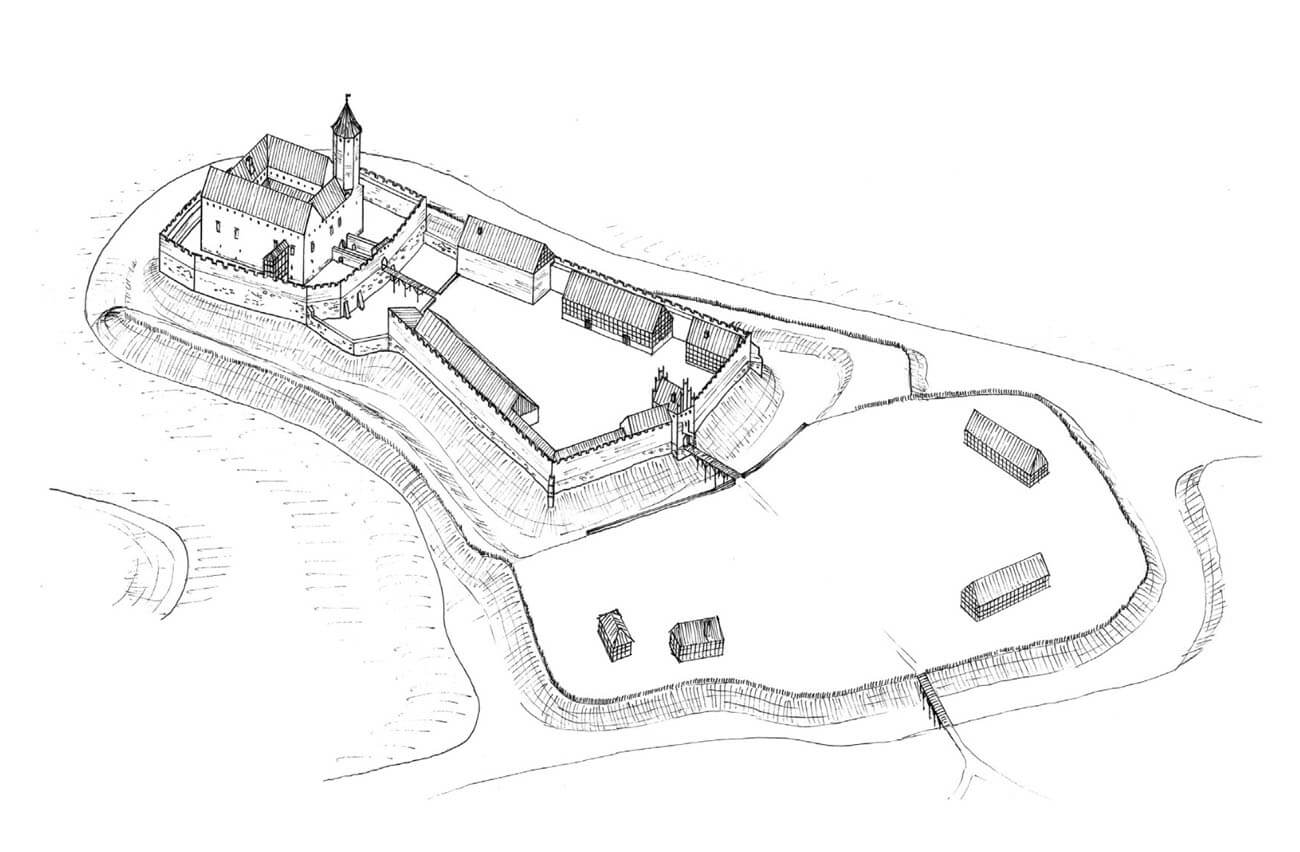History
The oldest record of Lipienek (German: Leipe, Lippinken) came from 1277, when the first, still wood – earth Teutonic stronghold was besieged by Prussians under Skomand command. The brick castle was built by the Teutonic Knights probably in the years 1300-1330, as the seat of the Chełmno teutonic commander, and after the liquidation of this commandry around 1335-1337 (it was replaced by the commandry in Brodnica), as the seat of the Teutonic vogt (“advocatus in Lippa”). The vogt performed judicial and administrative power over the knighthood, whose goods were located in his subordinate area. He also headed the banner of the knights of this land. The importance of the Lipienek vogt was confirmed by the selection to this dignity of the closest and most trusted followers of grand masters and the central location of Lipienek in relation to the surrounding commandries.
The castle was so strong that in the autumn of 1330 Polish king Władysław Łokietek was unable to obtain it, despite the support provided by the Hungarian and Lithuanian armies, and also despite having siege machines. After the plunder of the local area, the king was forced to enter into a truce with the Teutonic Knights, probably in the presence of the Land Commander of the Chełmno Land, Otto von Lauterberg, who commanded the defense. Many important documents were published at the castle in Lipienek, including the foundation privilege of Grudziadz town from 1291. In the fifteenth century, the Teutonic vogt of Lipienek, one of the outstanding Teutonic Knights, George von Egloffstein, wrote here part of the Great Masters Chronicle, a work of considerable value. From 1374, the records of three cannons located at the castle in Lipienek also comes from. This is the first information about powder artillery in the present Polish lands.
In 1410, the Teutonic vogt of Lipienek co-organized the mobilization of armed units for the Grunwald expedition. After the Battle of Grunwald, when the knights and knechts of the Chełmno land turned against the Teutonic Knights, the castle was temporarily occupied by the army of King Władysław Jagiełło. However the Poles limited themselves to looting supplies and left Lipienek that same year. In 1411, the leader of the Lizard Union, Nicholas of Ryńsk was arrested during the feast in the castle. Delivered to the castle in Grudziądz, he was beheaded on the market without trial, after a few days. As a reward for his capture, Teutonic vogt Heinrich Hold was promoted to the commander of the castle in Radzyń Chełmiński, and later in Toruń.
In 1466, under the Second Peace of Toruń, the Thirteen Years’ War ended, as a result of which the castle was permanently incorproated to Poland. From that time until 1655 it was the seat of Polish starosts from the Kostka family and people related to it. The last staroste of the family was Stanisław Franciszek Kostka, after him the staroste was taken over by Albrecht Czerski. The buildings were partially destroyed during the Polish-Swedish wars in the 17th century, and after the first partition of Poland in 1772, were mostly dismantled by the Prussians.
Architecture
The brick and stone castle was erected on an elongated, high peninsula, on the eastern shores of the lake, into which numerous streams flowed. During the construction, the earth ramparts of the early medieval stronghold and probably the older Teutonic watchtower were used. The castle consisted of a brick outer bailey on a trapezoidal plan and an upper ward (commandry house) on its western side, situated on a square hill with cut corners. On the eastern side, at the base of the promontory, there was second outer bailey, but of a wood and earth construction. The individual parts of the complex were separated from each other by a deep moats. From the south, a transverse ditch between the first outer bailey and the main part of the castle was limited by a characteristic, bent wall.
The upper ward was a regular complex with sides of about 35 x 38.5/39.7 meters, consisting of four wings closing the inner courtyard. Thus, it was one of the oldest Teutonic regular castles in the Chełmno land and in the Teutonic Knight’s state, and at the same time one of the smallest. Probably in its north-eastern corner there was a main tower with the function of a bergfried, protecting the entrance from the outer bailey. The castle also had an external wall forming a zwinger, on which in the 16th century there was a wooden bathhouse. The outer wall was not high. It ran along the artificially formed edge of the hill, similar in shape to a square with side lengths from 63 to 66 meters. Zwinger towered over the area at the foot of the hill by about 4-5 meters. The gate was located on the east, from the side of the fortified outer bailey, but not in the middle of the eastern wing, but slightly shifted to the north of the axis. Its protection was provided by a moat 18-22 meters wide.
The upper ward had a cellars, two above-ground storeys and a warehouse attic. It was a typical arrangement of the Teutonic castles. Two cellars were located under the east wing, two under the south and one under the north. The basement rooms were vaulted and accessible from the courtyard level with long necks. The courtyard was paved and surrounded by brick, vaulted cloisters enabling communication between rooms of all wings. The stairs leading to the first floor were located in the southern part of the east wing and at the north wing. In the ground floor of the west wing there was a vaulted kitchen with a huge chimney and a bakery. The other rooms on the ground floor probably also had economic functions. On the first floor there must have been the most important rooms of the commandry: the refectory, dormitory and chapel. Their layout is no longer possible to reconstruct, but probably the main wing with the chapel (above the passage) was the eastern part, and the least important was west wing (above the bakery and kitchen). The chapel could also be located in the eastern part of the southern wing, thanks to which it would maintain orientation and could be adjacent to the refectory. The attic had a warehouse function. Probably as in the other Teutonic Knights castles a defensive porch ran around it. Inside the main tower there was a vaulted small dungeon and a spiral staircase in the thickness of the walls. Tower probably did not have direct connection with nearby wings. For defensive reasons, it was separated from the northern and eastern wings by a free space about 2 meters wide.
The entrance to the outer ward led from the east by a drawbridge over a moat, which could have bricked edges. Its width was about 25-27 meters. After crossing the bridge, a gatehouse measuring 7.3 x 9.8 meters and a wall thickness of 1.7 meters was reached. Over the gateway, it had one storey, and according to early modern lustration, gothic gables. The outer ward had various types of buildings on almost all sides. Only the western side leading to the upper castle was empty. To the south of the gatehouse stood a two-storey building with dimensions of 11.5 x 6.5 meters with three chambers in the ground floor and two rooms, a hall and a chamber on the first floor. Three buildings stood at the north wall in the middle of the 16th century. In the north-eastern corner, the so-called servant’s house, added to the wall in such a way that two new walls were erected in a timber-frame construction on a stone foundation. The building had basement and one-story with three rooms and a toilet. It had dimensions 13 x 9 meters and two gables: one wooden, the other one brick. Further to the west by the northern curtain there was a stable, built in half-timbered construction on a stone foundation measuring 31 x 11 meters. The interior of its ground floor was divided into four rooms, and the attic served as a granary. At the north – west corner there was a brick, two – story building with cellar, measuring 25 x 9 meters. It had two basements accessible by necks, five rooms in the ground floor (including one with a latrine and one lined with wood) and an entry hall. On the first floor there were two rooms and a large hall. At the southern curtain of the outer ward, there was a half-timbered barn with dimensions of 30 x 6.6 meters, with two attached parts (brick and wooden) and an attic serving as granary. Further to the west stood a barn with dimensions 32 x 13 meters. All these buildings were covered with one roof and thatched roofs. At the end, in the south-western corner, a half-timber coach house with dimensions of 17.3 x 9.5 meters was added. Between the outer and the upper castle there was the already mentioned moat and a small wall (5.5 meters). From the south, both the outer ward and the upper castle were protected by an earth rampart.
In the Middle Ages, great economic importance for the castle in Lipienek had a farm, dealing with cattle and horses. In the mid-sixteenth century, it consisted of two barns, a brewery and a horse mill. The farmstead could be at the base of the peninsula, going into the mainland, acting as a second external ward. Its entirely timber buildings were secured by a moat that is still visible until today on the south-eastern side.
Current state
The basements of the of the southern and northern wings of the upper ward, the basement of the north-eastern building in the outer bailey and the solid stone walls of the zwinger surrounding the relics of the commandry house have survived to this day. The eastern cellar chamber of the southern wing has preserved a barrel vault. The traces of the moat and the embankment of the bridge causeway are also visible. The former lake is mostly swampy terrain today, while the ruins are largely overgrown with dense vegetation.
bibliography:
Leksykon zamków w Polsce, red. L.Kajzer, Warszawa 2003.
Torbus T., Zamki konwentualne państwa krzyżackiego w Prusach, część II, katalog, Gdańsk 2023.
Wasik B., Budownictwo zamkowe na ziemi chełmińskiej od XIII do XV wieku, Toruń 2016.
Wasik B., Zamek w Lipienku na ziemi chełmińskiej, “Rocznik Grudziądzki”, nr 21, 2013.
Wasik B., Wiewióra M., Lipienek i Starogród – wyniki badań archeologiczno-architektonicznych przeprowadzonych w 2018 roku, „Castellologica Bohemica”, 19/2020.




